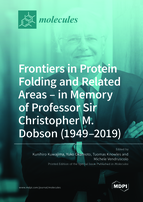Frontiers in Protein Folding and Related Areas – in Memory of Professor Sir Christopher M. Dobson (1949–2019)
A special issue of Molecules (ISSN 1420-3049). This special issue belongs to the section "Bioorganic Chemistry".
Deadline for manuscript submissions: closed (31 May 2022) | Viewed by 53545
Special Issue Editors
Interests: protein folding; molten globule; molecular chaperone; stopped flow; hydrogen exchange
Interests: protein folding; protein misfolding; enhanced conformational sampling; generalized-ensemble algorithms; molecular simulations
Interests: protein aggregation; protein misfolding diseases; biophysics
Interests: protein folding; protein misfolding; protein aggregation; protein homeostasis; protein misfolding diseases
Special Issues, Collections and Topics in MDPI journals
Special Issue Information
Dear Colleagues,
Protein folding is a fundamental theme in molecular biology. Elucidation of the molecular mechanisms of this process has challenged molecular biologists for over half a century. Although computational methods have now achieved remarkable success in the prediction of native structures, the fundamental principles of the protein folding process have yet to be fully elucidated. In addition, we still have an incomplete understanding of the components of the protein homeostasis system, which controls protein folding in the cellular environment. Furthermore, failures in protein folding may lead to misfolding and aggregation, a phenomenon closely related to a wide range of human disorders, including Alzheimer’s and Parkinson’s diseases and type II diabetes. This Special Issue is dedicated to the memory of the late Professor Sir Christopher M. Dobson, who made outstanding contributions to the advancement of studies of protein folding and the related areas and played an irreplaceable role in the promotion of protein science.
We look forward to receiving your contributions.
Yours sincerely,
Prof. Dr. Kunihiro Kuwajima
Prof. Dr. Yuko Okamoto
Prof. Dr. Tuomas Knowles
Prof. Dr. Michele Vendruscolo
Guest Editors
Manuscript Submission Information
Manuscripts should be submitted online at www.mdpi.com by registering and logging in to this website. Once you are registered, click here to go to the submission form. Manuscripts can be submitted until the deadline. All submissions that pass pre-check are peer-reviewed. Accepted papers will be published continuously in the journal (as soon as accepted) and will be listed together on the special issue website. Research articles, review articles as well as short communications are invited. For planned papers, a title and short abstract (about 100 words) can be sent to the Editorial Office for announcement on this website.
Submitted manuscripts should not have been published previously, nor be under consideration for publication elsewhere (except conference proceedings papers). All manuscripts are thoroughly refereed through a single-blind peer-review process. A guide for authors and other relevant information for submission of manuscripts is available on the Instructions for Authors page. Molecules is an international peer-reviewed open access semimonthly journal published by MDPI.
Please visit the Instructions for Authors page before submitting a manuscript. The Article Processing Charge (APC) for publication in this open access journal is 2700 CHF (Swiss Francs). Submitted papers should be well formatted and use good English. Authors may use MDPI's English editing service prior to publication or during author revisions.
Keywords
- protein folding
- amyloid and human diseases
- protein design
- protein structure prediction
- protein dynamics and molecular simulations
- protein quality control
- molecular chaperones










